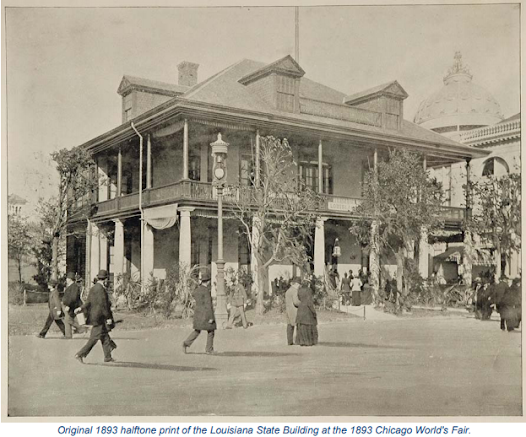Aug. 10, 1893, was Louisiana Day at the World's Fair: Columbian Exposition in Chicago, IL. This world's fair celebrated the 400th anniversary of Christopher Columbus' arrival in the New World in 1492. Dedication ceremonies for the fair were held on Oct. 21, 1892, but the fairgrounds were not open to the public until May of 1893 and ran for six months closing in Oct.
The planning began nearly ten years before the dedication ceremony. Many prominent civic, professional, and commercial leaders from across the nation participated in the fair's financing, coordination, and management. The total cost of the fair was approximately $46,000,000, which is the equivalent of nearly 1.4 billion dollars today. There were forty-six countries, 34 U.S states, and 4 U.S. territories with buildings at the exposition.
To have a state building or headquarters meant having a proper representation of their resources at the world's fair. Early estimates suggest that the appropriation needed was at least $75,000. But, the Louisiana legislature only appropriated $36,000, and $12,000 of that was earmarked for the two commissioners, which ruffled quite a few feathers. Since $24,000 was not enough money to provide proper representation, Columbian Clubs began to form throughout the state.
In an article appearing in the "Weekly Shreveport Times" on Mar. 5, 1893, the writer stated that "Louisiana was too poor – floods and legislative inaction throwing the burden of making a display upon the women of the state." An article in "The Bossier Banner" on Aug. 11, 1892, supports this statement; it reads as follows:
"It is to our credit as a parish that the ladies, always active and enthusiastic in any good cause, are evincing interest in organizing for the purpose of raising funds for our State exhibit at the World's Fair. That we have at present two Columbian Clubs, one at Cottage Grove, and one at Benton, both organized with good membership, surely speaks well for the ladies of said places and vicinity, reflecting great credit on their public spirit."
 |
| Martha "Mattie" Gilmer Swann c. 1905 Ann Fitzpatrick Graham Collection: 2003.007.016D |
Earlier that year, Dr. W. M. Abney, President of the Police Jury, with the unanimous approval of the jurors, appointed Martha “Mattie” Swann as the parochial delegate from Bossier Parish to the World's Fair. She was instrumental in the organizing of these local clubs. Shortly after the article ran announcing the two Bossier Parish clubs, she visited Plain Dealing, where a third Columbian Club was organized in this parish. Again, the officers of the club were made up entirely of women from that community.
These clubs held elaborate affairs to raise money for the Louisiana State Exhibit building at the World's Columbian Exposition. The Columbian Club at Cottage Grove held the first of these affairs at Swannhaven plantation, home of Mattie Swann. Guest enjoyed supper and entertainments complete with recitations, tableaux, soliloquies, instrumental duets, horseshoe quartets, and other musical numbers. The night was concluded with an address from Mrs. Julia Rule, Pansy of the Times, "to arouse enthusiasm in our State Columbian work."
 |
| Swannhaven Plantation, Cottage Gove, Louisiana, c. late 1800s Ann Fitzpatrick Graham Collection: 2003.007.007 |
Next, the Benton Columbian Club prepared a feast that was given at the Union Hotel supper-room. The write-up in the “Shreveport Times,” provides the following description. “The contributions to this supper were most generous, and some responded who were not members of the club; long tables groaned ‘neath the weight of delicious salads, cakes, beautiful jellies and appetizing pickles – all ‘home products’ – as were the barbecued meats, daintily trussed turkeys and chickens galore!”
Both events were filled with dancing and merriment, and the ladies' efforts were rewarded by the “...large and appreciative crowds, whose patriotism and pride in our fair State’s representation at the coming magnificent exposition...”
 |
| Louisiana Day, Aug. 10, 1893, World's Columbian Exposition, Chicago, IL Source: Digital Research Library of Illinois History |
The Louisiana state building was an exhibit of authentic southern architectural style and was divided into eight rooms. One devoted to the Acadian exhibits, from the quaint old French colony in the lovely Bayou Teche country. Another room was devoted to the relics of the French and Spanish days of Louisiana. Richly carved antique furniture of a former Governor, which was usually kept at the museum of the Capitol building at Baton Rouge, filled one of the rooms.
There were eleven beautifully carved panels designed and executed by women of the State. And many other interesting articles, including a veranda of Louisiana woods, where each visitor was given a seedling of a cypress tree, resulting in the spread of cypress trees to areas where they were not native, of which many can be found in West Virginia.
When it comes to agriculture, there was also a double-decked Chinese pagoda, artistically finished off in rough rice, where samples of rice were given to the ladies that visited. In a massive pillared veranda made of sugar cane were displays of syrups, molasses, and sugars, including the old sugar-loaf cakes. There was an exhibit of ramie hemp and other fiber plants, corn, and tobacco.
Of course, it wouldn't be a true representation of Louisiana without its food and music. So naturally, a Creole kitchen served all the southern delicacies for which the state is noted, and a Creole concert company entertained the many visitors.
The World’s Columbian Exposition was the most significant world's fair in U.S. history and one of the most important in the history of world expositions. The Ferris wheel made its debut at the fair, as did the brownie, among other things. The architecture shaped the country's style for the next 25 years and the exhibits were more impressive than anything seen before. It introduced the concept of the midway, a lively entertainment zone, a feature that soon became a staple of virtually all future expositions.
By: Amy Robertson

No comments:
Post a Comment